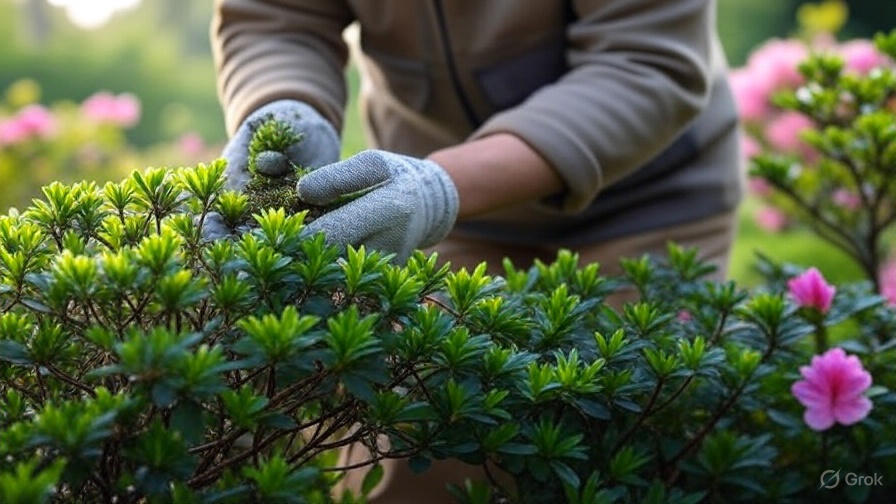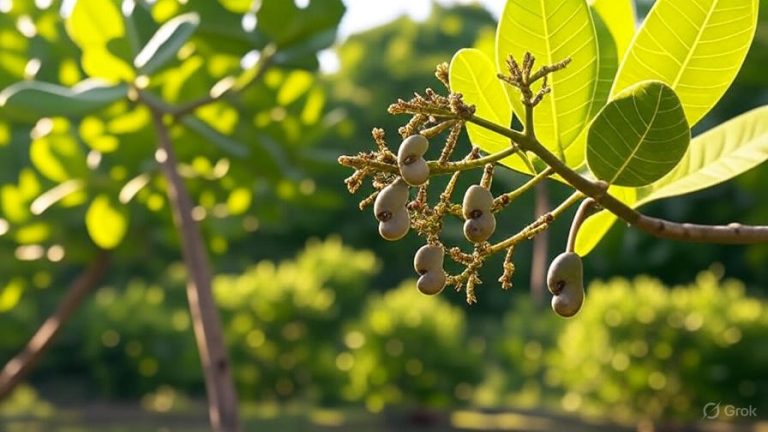How to Remove Moss from Azaleas?
Moss growing on your beautiful azalea bushes can transform these stunning flowering shrubs into unsightly, green-covered masses. This common garden problem affects thousands of homeowners who watch helplessly as their prized azaleas disappear under thick moss blankets. The good news? You can restore your azaleas to their former glory with the right techniques and consistent care.
Moss thrives in specific conditions that often coincide with azalea growing environments. High humidity, poor air circulation, and excessive moisture create the perfect storm for moss invasion. Your azaleas don’t just look bad when covered in moss – they actually suffer from reduced photosynthesis, limited air circulation, and increased susceptibility to diseases.
Why Moss Attacks Your Azaleas
Azaleas naturally prefer acidic soil and partial shade, conditions that moss absolutely loves. This overlap in environmental preferences explains why moss problems plague azalea gardens more frequently than other landscape areas. The shallow root system of azaleas also means they compete poorly with moss for surface moisture and nutrients.
Dense moss coverage blocks sunlight from reaching azalea leaves, preventing proper photosynthesis. This reduction in energy production weakens the entire plant, making it more vulnerable to pests, diseases, and environmental stress. The moss also traps moisture against the bark and branches, creating ideal conditions for fungal infections and rot.
Climate plays a crucial role in moss development. Areas with high rainfall, frequent fog, or naturally humid conditions see more aggressive moss growth. Pacific Northwest gardens, southeastern regions with high humidity, and areas near water bodies experience the most severe moss problems on azaleas.
Identifying Different Types of Moss on Azaleas
Sheet moss appears as flat, carpet-like growth covering large areas of azalea branches and trunks. This type spreads quickly and can cover entire sections of your shrub within a single growing season. Sheet moss feels soft and spongy when touched and holds significant amounts of water.
Cushion moss forms small, rounded mounds that look like green pillows scattered across your azalea’s surface. This moss type grows more slowly than sheet moss but proves more difficult to remove due to its dense, compact structure. Cushion moss often indicates areas with particularly poor air circulation.
Haircap moss creates tall, upright structures that resemble tiny forests growing on your azalea branches. This moss variety thrives in consistently moist conditions and often appears where water drips regularly from overhead branches or structures.
Rock cap moss forms thin, crusty layers that adhere tightly to bark surfaces. This type appears almost painted onto the azalea and requires more aggressive removal techniques. Rock cap moss often indicates areas with mineral deposits from hard water or fertilizer residue.
Assessing the Severity of Moss Infestation
Light moss coverage affects less than 25% of your azalea’s surface area and appears primarily on the trunk and main branches. At this stage, manual removal proves most effective, and your azalea will recover quickly once the moss disappears.
Moderate infestations cover 25-50% of the plant surface and begin extending onto smaller branches and twigs. These situations require combination approaches using both manual removal and environmental modifications to prevent immediate regrowth.
Heavy moss coverage exceeds 50% of the plant surface and may include moss growth on leaves themselves. Severe cases like this demand aggressive treatment and may require professional intervention to save the azalea.
Complete moss coverage indicates a systemic problem with growing conditions. These extreme cases often coincide with other plant health issues and require comprehensive treatment plans addressing multiple factors simultaneously.
Manual Moss Removal Techniques
Hand removal works best for light to moderate moss infestations. Start by gently peeling moss away from the bark using your fingers or soft brushes. Work systematically from the bottom of the plant upward, ensuring you remove moss from all visible surfaces.
Soft-bristled brushes effectively remove stubborn moss without damaging delicate azalea bark. Old toothbrushes work perfectly for detailed work around branch joints and crevices. Scrub gently in circular motions, allowing the moss to separate naturally from the bark surface.
Pressure washing offers a quick solution for extensive moss coverage but requires careful technique. Use the lowest pressure setting and maintain a distance of at least two feet from the plant. Direct the water spray at a downward angle to avoid forcing water into branch crotches where it might cause damage.
Plastic scrapers help remove thick moss layers without scratching bark surfaces. Work the scraper edge under moss sections and lift gently. This technique works particularly well for sheet moss that has formed thick mats on trunk surfaces.
Chemical Solutions for Moss Control
Copper sulfate solutions effectively kill moss while remaining relatively safe for azaleas when properly diluted. Mix one tablespoon of copper sulfate per gallon of water and spray directly onto moss-covered areas. Apply on calm days to prevent drift onto desirable plants.
Iron sulfate provides another effective moss control option that actually benefits azaleas by lowering soil pH. Create a solution using two tablespoons of iron sulfate per gallon of water. This treatment kills moss while providing iron nutrition that azaleas require for healthy growth.
Commercial moss killers designed for ornamental plants offer convenient, pre-mixed solutions. Look for products specifically labeled as safe for acid-loving plants like azaleas. These formulations typically contain iron or copper compounds in appropriate concentrations.
Dish soap solutions provide a gentler approach for sensitive gardeners. Mix two tablespoons of liquid dish soap per gallon of water and spray onto moss areas. The soap disrupts moss cell walls and makes removal easier without introducing harsh chemicals to your garden.
Natural and Organic Moss Removal Methods
Baking soda creates an alkaline environment that moss cannot tolerate. Sprinkle baking soda directly onto moss-covered areas and allow it to sit for 24 hours before brushing away dead moss. This method proves especially effective for small, localized moss patches.
White vinegar acidifies surfaces and kills moss through pH shock. Spray undiluted white vinegar directly onto moss during sunny weather for maximum effectiveness. The combination of acetic acid and sunlight quickly browns and kills moss growth.
Corn gluten meal acts as a natural moss suppressant while providing slow-release nitrogen for your azaleas. Spread a thin layer around the base of affected plants and work lightly into the soil surface. This organic treatment prevents moss spore germination.
Beneficial bacteria products introduce natural moss competitors into your garden ecosystem. These biological controls establish populations that outcompete moss for nutrients and space. Apply according to manufacturer directions during mild weather conditions.
Improving Growing Conditions to Prevent Moss
Air circulation plays a critical role in moss prevention. Prune nearby shrubs and trees to increase airflow around your azaleas. Remove lower branches that touch the ground and thin dense growth to allow air movement through the plant canopy.
Soil drainage improvements reduce the moisture levels that moss requires for establishment. Install French drains in problem areas or amend heavy clay soils with organic matter to improve water infiltration. Raised beds offer another solution for chronically wet locations.
Sunlight exposure significantly impacts moss growth rates. Selective pruning of overhead branches can increase light levels without exposing azaleas to harsh direct sun. Aim for bright, filtered light conditions that benefit azaleas while discouraging moss.
Watering practices directly influence moss development. Water azaleas at soil level rather than overhead sprinkling to keep foliage and bark surfaces dry. Install drip irrigation systems to deliver water precisely where plants need it without creating surface moisture.
Seasonal Moss Management Strategies
Spring moss removal takes advantage of active plant growth periods when azaleas recover quickly from treatment stress. Remove moss after the last frost but before new growth begins. This timing allows maximum recovery time before summer heat stress.
Summer maintenance focuses on preventing moss regrowth through environmental management. Increase air circulation, reduce overhead watering, and monitor moisture levels around treated plants. Light moss infestations can be hand-removed during this period.
Fall preparations involve thorough moss removal before winter dormancy. Clean all visible moss from azalea surfaces and apply preventive treatments to reduce spring regrowth. This timing takes advantage of cooler temperatures that reduce plant stress.
Winter monitoring allows early detection of moss regrowth during humid months. Check azaleas monthly for new moss development and remove small patches immediately before they establish. Cold weather makes moss removal easier and less stressful for plants.
Long-term Moss Prevention Strategies
Proper plant spacing prevents the crowded conditions that promote moss growth. Space azaleas according to their mature size to ensure adequate air circulation between plants. Overcrowded plantings create microclimates perfect for moss development.
Mulching practices significantly impact moss establishment. Use organic mulches like pine needles or shredded bark that complement azalea growing requirements while suppressing moss growth. Avoid mulches that retain excessive moisture against plant stems.
Regular maintenance schedules help catch moss problems before they become severe. Inspect azaleas monthly for signs of moss development and address issues immediately. Early intervention prevents extensive infestations that require aggressive treatment.
Plant health management reduces moss susceptibility by maintaining vigorous azalea growth. Provide appropriate fertilization, maintain proper soil pH, and address pest or disease issues promptly. Healthy plants resist moss invasion more effectively than stressed specimens.

Common Mistakes to Avoid
Over-aggressive removal techniques can damage delicate azalea bark and create entry points for diseases. Avoid using stiff brushes, harsh chemicals, or high-pressure water that might harm plant tissues. Gentle, persistent efforts prove more effective than forceful approaches.
Ignoring underlying causes ensures moss will return quickly after removal. Address drainage problems, air circulation issues, and excessive moisture before expecting permanent results. Treating symptoms without addressing causes leads to frustrating cycles of moss regrowth.
Chemical overuse can harm beneficial soil organisms and damage azalea roots. Follow label directions carefully and avoid excessive applications that might accumulate in soil. Organic methods often prove safer and more sustainable for long-term moss control.
Timing errors reduce treatment effectiveness and may stress plants unnecessarily. Avoid moss removal during hot summer weather or when plants show stress from drought or disease. Choose mild weather conditions that allow plants to recover quickly from treatment.
Tools and Equipment for Moss Removal
Soft-bristled brushes protect delicate azalea bark while effectively removing moss growth. Natural bristle brushes work better than synthetic materials for this application. Keep several sizes available for different moss removal tasks.
Sprayers allow precise application of liquid treatments without waste or drift. Choose adjustable nozzles that provide both fine mist and stream settings. Clean sprayers thoroughly between different chemical applications to prevent contamination.
Protective equipment keeps you safe during moss removal activities. Wear gloves when handling chemicals, eye protection during pressure washing, and appropriate clothing for outdoor work. Safety equipment prevents injuries and chemical exposure.
Collection containers help organize moss removal debris and prevent spreading spores to clean areas. Use tarps or buckets to collect removed moss and dispose of it away from garden areas. Proper disposal prevents immediate recontamination.
Professional vs. DIY Moss Removal
DIY approaches work well for light to moderate moss infestations when homeowners have time and patience for systematic treatment. Manual removal, natural remedies, and basic environmental improvements fall within most gardeners’ capabilities.
Professional services make sense for severe infestations, large properties, or situations involving valuable specimen plants. Professionals have access to commercial-grade equipment and treatments not available to homeowners.
Cost considerations favor DIY methods for small-scale problems but professional treatment may prove more economical for extensive infestations. Calculate the value of your time, cost of materials, and probability of success when making this decision.
Safety factors sometimes dictate professional treatment, especially when working with tall plants, steep slopes, or near power lines. Professional crews have appropriate equipment and training for hazardous situations.
Maintaining Moss-Free Azaleas
Regular inspection schedules help maintain moss-free azaleas through early detection and prompt treatment. Check plants monthly during humid seasons and weekly during peak moss growth periods. Consistent monitoring prevents small problems from becoming major infestations.
Environmental monitoring tracks conditions that promote moss growth. Use humidity gauges, moisture meters, and visual assessments to identify areas prone to moss development. Proactive environmental management prevents moss establishment.
Treatment records help track what works and what doesn’t in your specific garden conditions. Keep notes on treatment methods, timing, and results to refine your moss management strategy over time. Successful approaches can be repeated while failures are avoided.
Plant health assessments ensure azaleas remain vigorous enough to resist moss invasion. Monitor growth rates, flowering performance, and foliage quality as indicators of plant health. Address declining health immediately to prevent moss susceptibility.
The battle against moss on azaleas requires patience, persistence, and proper technique. Success comes from combining effective removal methods with long-term prevention strategies that address underlying causes. Your azaleas will reward your efforts with improved health, better flowering, and enhanced garden beauty when freed from moss coverage. Regular maintenance and environmental management ensure moss problems don’t return, protecting your investment in these magnificent flowering shrubs for years to come.







